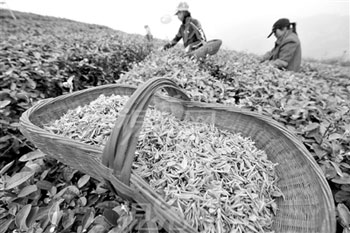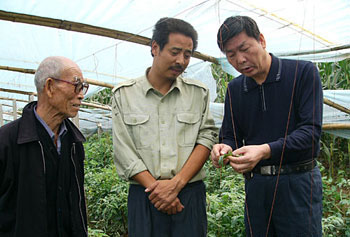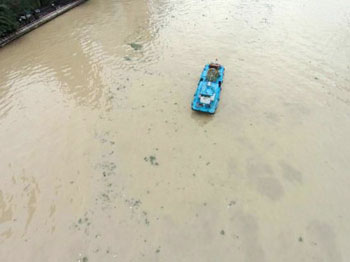Tea trees rely on science and technology without pesticides.
Original question: Is it really OK for tea trees not to apply pesticides?

Pre-Ming tea and pre-rain tea are the names of spring tea in different stages according to solar terms in Jiangnan tea area of Yangtze River Basin in China.
Before Ming Dynasty tea was collected before Qingming Festival, and before rain tea was collected before grain rain after Qingming Festival. The quality of tea before Ming Dynasty is good, the quality of tea before rain is still good, and the tea before summer after grain rain is generally coarse and old, and the quality is poor.
"Tea picking song in the spring old", Qingming around, and to the spring tea market season.
As an important drink for Chinese people, tea has attracted much attention for its safety. Although the harmfulness of pesticide residues in tea still has different voices in academic sessions, the relevant reports of "excessive pesticide residues in tea" also make many people wonder. Is there any tea tree without pesticides?
On March 27, in the ten thousand mu organic tea garden of ecological agriculture in Jiangxi Qixin Town, the Institute of Botany of the Chinese Academy of Sciences unveiled the "Demonstration Base for Plant Screening and Experiment of Subtropical Ecological Agriculture Resources in Qixin Town", and both parties jointly explored scientific and technological solutions.
--frontline observation--
What kind of mountain seeds are there in the tea garden?
Qianxin Town is located in Longnan County, Ganzhou, Jiangxi Province, which is the cradle of Hakka. It belongs to Jiulian Mountain, a national nature reserve, surrounded by hundreds of thousands of mu of original ecological forest. After a spring rain, the mountains were surrounded by clouds, just like a fairyland.
"The tea leaves are growing very well this year. The estimated yield will reach 60,000 kilograms." According to Liao Chenglong, head of Qiancha Base in Qianxin Town,"Qian" is the title of ancient Ganzhou, and "Qian Tea" has a history of thousands of years. "In the past, we only knew that navel orange was the fist agricultural product in the old district of Gannan. Now through our efforts, Qiancha organic tea is becoming a new business card of modern agriculture in Gannan." Liao Chenglong said that last year, the organic tea output of Qixin Town was 50,000 kilograms, and the sales revenue had exceeded 100 million yuan.
Walk in ten thousand mu organic tea garden, physical sticky insect board all over the mountains, solar energy pest control lamp stands in the tea tree. Liao Chenglong folded a small piece of stem and leaf of a plant and gave it to the reporter: "You smell it, is there a strong ginger fragrance?" This is the Litsea cubeba seed that we planted in the tea trees. It is also the secret weapon of the tea garden plants to expel insects. Our tea trees do not use pesticides or chemical fertilizers. The entire tea garden is planted with hundreds of thousands of Litsea cubeba seeds."
The anthelmintic effect of Litsea cubeba seeds on tea plants came from the accidental discovery of agronomists. "This plant originally grew in patches on two hills. At the beginning of the construction of the tea garden, in order to maintain the shady environment of tea seedlings, they were accidentally preserved. Later. Our agronomists found that the tea seedlings in the area where the seeds are located are very few pests, and the two-year-old tea plants grow as well as the four-year-old ones." Liao Chenglong said.
For this cooperation with the Institute of Botany of the Chinese Academy of Sciences, Liao Chenglong told reporters: "We see that the mountain ash seed repels tea plant diseases and insect pests is only a phenomenon, how does it work?" How big is this impact? How many cubeba seeds are more effective in a tea garden? We hope that the scientific and technological personnel can solve our problems and provide technical and R & D support for us to make green organic tea."
--Expert opinion--
Citral is an effective pest repellent.
At the beginning of this year, the Institute of Botany of the Chinese Academy of Sciences set up a research demonstration base in Qixin Town, mainly studying the screening and experiment of subtropical ecological agricultural resources plants, providing support for the construction of Qixin Town, the ecological environment construction in subtropical regions of China and the adjustment of agricultural industrial structure.
Bai Hongtong, senior experimenter of the Institute of Botany of the Chinese Academy of Sciences, told reporters that they set up a demonstration base in Pixin Town this time. One of the important studies is to make clear the interplanting of Litsea cubeba seeds and tea trees, the insect repellent effect on the latter, and the impact on the local soil aggregate structure.
In fact, Litsea cubeba seed is a kind of plant used by Hakka ancestors long ago to expel insects. The oil boiled from the fruit has a good mosquito repellent effect, and the branches and leaves themselves are very good green manure. "About 80% of the seeds are citral, which has a good repellent effect on pests. It ranks first in China's spice exports. However, the specific effect of Litsea cubeba seeds on tea tree pests has not been specifically studied scientifically." Bai Hongtong said.
For the scientific research work of the base how to carry out, Bai Hongtong told reporters, They in Qian tea garden is mainly to do experimental fields, According to the experimental design placed devices, Through the construction of flora, Study the change of pests, Test soil aggregate structure, PH value, Nitrogen, phosphorus and potassium elements changes.
Interplanting mode improves tea quality
In the Qian tea garden, it is easy to see that there is another plant interplanted in the tea plant-yew. Liao Chenglong explains that Jiulian Mountain National Forest Park, only a few dozen kilometers away from the tea garden, is the largest natural community of Taxus chinensis var. mairei. Qian Tea Garden initiated the interplanting mode of tea tree and Taxus chinensis by taking advantage of the favorable weather and geographical position, realizing the same growth and interest of the two, so as to improve the quality of tea.
Taxus chinensis, known as a "natural oxygen-generating machine," contains rare anti-cancer substances such as paclitaxel. "This kind of interplanting definitely has an impact on the aggregate structure of the soil, but how much influence and what kind of influence it will have need further scientific experiments." Bai Hongtong said.
this is another important task of the demonstration base. Bai Hongtong said: "In addition to the research on Qiancha Tea Garden, we also need to establish a resource spectrum for introduction in the local area, initially focusing on one or two hundred subtropical plants with aromatic, ornamental, or economic value." Rosemary, for example, is a spice plant with a very long industrial chain. The antioxidants extracted from it are recognized worldwide as the best natural antioxidants. After the introduction, it is hoped that experiments can be carried out in many places. We will see if we can achieve industrialization and build a new type of ecological agriculture to bring more economic benefits to local farmers."
Bai Hongtong's team once cooperated with the 69th Regiment in the National Science and Technology Support Plan to introduce advanced technology for the latter, establish factory seedling raising and rapid propagation system, formulate cultivation technical specifications conducive to improving the yield of spice plants and optimizing the target quality, so as to gradually form a lavender spice industry chain integrating breeding, production, processing and sales.
--Industry thinking--
To be high-end organic, we must rely on technology.
When interviewing in Devotion Town, you can clearly feel the expectation of local residents for science and technology. As Liao Chenglong said: "To do a good job in modern agriculture, we must rely on science and technology!" As we continue to develop, we increasingly feel that to make high-end organic tea, we must rely on technology. Just like Professor Bai said, use ecological methods to construct a biological community."
Qian Tea Garden's expectation of science and technology is a microcosm of modern agriculture's demand for science and technology. From the perspective of current and future development, the pressure of ecological environment protection is increasing, and the public demand for green and organic agricultural products is becoming more and more vigorous. To develop modern agriculture, we must rely on the support of science and technology and the drive of innovation, and strive to walk out of a road of agricultural modernization with high output efficiency, product safety, resource conservation and environmental friendliness.
The ultimate goal of the "marriage" between the Institute of Botany of the Chinese Academy of Sciences and the town is to provide technical support for the construction of ecological environment and the adjustment of agricultural industrial structure in subtropical regions of China. At present, our country is in the critical period of promoting the synchronous development of industrialization, informatization, urbanization and agricultural modernization and building a well-off society in an all-round way. To promote agricultural modernization, we must innovate the collaborative innovation mechanism of government, industry, research and application, perfect the market-oriented mechanism of enterprise technological innovation, and make enterprises become the main body of decision-making, investment, organization and application of technological innovation. We will improve the incentive mechanism for the transformation of achievements, promote the transfer and transformation of scientific and technological achievements, and solve the problem of "two skins" in scientific research and production and "the last kilometer" in scientific and technological services. (Written by our reporter Lin Lijun)
- Prev

Yang Lingliang has not been introduced to intellectual property in the world.
Yang Lingliang has not been introduced to intellectual property in the world.
- Next

General Forecast of Pearl River Prevention and Control: or reappearance of 1998 Flood
General Forecast of Pearl River Prevention and Control: or reappearance of 1998 Flood
Related
- A course of planting techniques and methods on how to grow carrots
- How to plant the latest tulips?
- Is it better to pick tea in the morning or in the afternoon? When is the best time for tea to be picked? what is the third or fifth tea?
- Launch Yuanxiao Happy combination Haocha + Tea Yuan healthy Taste
- Penghu Tourism "Fireworks 20 Parade with You"
- 2022 West Lake Happiness holds "Digital Revitalization Voucher" and draws iphone13 and laptop.
- Banqiao Fuzhou social houses are designed to change start-up combined with police elimination to create a safe and livable environment
- The convenient measure of "mechanical weeding" in Xinbei has been abused and the Agriculture Bureau has imposed heavy penalties on the illegal land consolidation.
- Changgeng University Joins Hands with Four Memory Factories to Rescue Memory Talent Shortage
- The list of Taiwan's top 100 MVP managers is listed by the Director-General of the Farmers' Association of Sanxia District.

